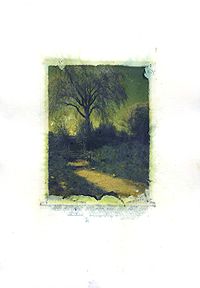
Polaroid transfer
Encyclopedia
Polaroid transfer is a photograph
ic image-transfer process, or print making technique, which uses Polaroid film. This way an image can be put on textiles, cups, glass and many other surfaces.
, enlarger, slide printer or Day Lab expose Polaroid film. You need pull-apart type film, such as Polaroid 669 (now discontinued, or Fuji FP100c, which is readily available). Develop by pulling the film from the holder. Wait about 10-15 seconds and quickly pull the film apart, not letting the two sides (the picture and the negative
) touch. Put the pulled apart negative face down on paper (or other material). Place pressure over negative and let sit for about 20 minutes. Then pour hot water over each side of the negative/paper sandwich. Gently peel the negative from the paper. Allow transfer to dry, face up.
Slide printers allow you to make polaroid transfers from previously-taken slides or negatives.

Photograph
A photograph is an image created by light falling on a light-sensitive surface, usually photographic film or an electronic imager such as a CCD or a CMOS chip. Most photographs are created using a camera, which uses a lens to focus the scene's visible wavelengths of light into a reproduction of...
ic image-transfer process, or print making technique, which uses Polaroid film. This way an image can be put on textiles, cups, glass and many other surfaces.
Brief How-To
Using a cameraCamera
A camera is a device that records and stores images. These images may be still photographs or moving images such as videos or movies. The term camera comes from the camera obscura , an early mechanism for projecting images...
, enlarger, slide printer or Day Lab expose Polaroid film. You need pull-apart type film, such as Polaroid 669 (now discontinued, or Fuji FP100c, which is readily available). Develop by pulling the film from the holder. Wait about 10-15 seconds and quickly pull the film apart, not letting the two sides (the picture and the negative
Negative (photography)
In photography, a negative may refer to three different things, although they are all related.-A negative:Film for 35 mm cameras comes in long narrow strips of chemical-coated plastic or cellulose acetate. As each image is captured by the camera onto the film strip, the film strip advances so that...
) touch. Put the pulled apart negative face down on paper (or other material). Place pressure over negative and let sit for about 20 minutes. Then pour hot water over each side of the negative/paper sandwich. Gently peel the negative from the paper. Allow transfer to dry, face up.
Slide printers allow you to make polaroid transfers from previously-taken slides or negatives.

Tips
- Watercolor paper is generally a good paper to use for this process. Keep in mind that you can use any paper surface, as well as other surfaces like wood, cloth, ceramic, etc.
- Wet the paper with hot water prior to transferring, the paper should be damp and may need to air dry or blotted with blotter paper.
- Bright light or sunlight can cause fading of transfer over time.
- Black and white polaroid film should not be used.
- 669, 59, 559, and 809 are all types of film that can be used.
See also
- Book: Polaroid Transfers by Kathleen Carr
- Book: Polaroid Manipulations by Kathleen Carr
- Photo emulsion
- Photographer's Guide to Polaroid Transfer Step-By-Step by Christopher Grey
- Fuji transfer Fuji transferThe Fuji transfer is a process of photo-image transferring using Fuji instant pull-apart film type FP100c and similar in general standard photo application uses to the popular Polaroid brand pull-apart film type 669....
- Inkjet transferInkjet transferInkjet transfer or Inkjet photo transfer is a technique to transfer a photograph or graphic, printed with an inkjet printer onto textiles, cups, CDs, glass and other surfaces....
- Polaroid
- Polaroid Image Transfer Instructions
- Polaroid TV

